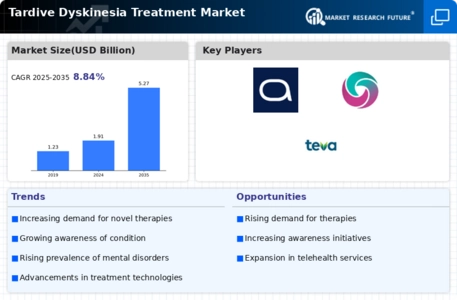The Tardive Dyskinesia Treatment Market is characterized by the rising prevalence of tardive dyskinesia, primarily induced by the prolonged use of antipsychotics. The increasing awareness of the condition and the unmet medical needs drive the demand for effective treatments.Technological advancements have led to the development of novel therapies, including gene editing techniques and neuromodulation devices, offering new avenues for symptom management. The market is further influenced by government initiatives and research collaborations aimed at improving patient outcomes.Recent trends indicate a shift towards personalized medicine, with tailored treatments based on individual patient profiles and genetic factors.
Additionally, there is a growing emphasis on early diagnosis and intervention, recognizing the importance of prompt treatment to prevent irreversible damage.
Tardive Dyskinesia Treatment Market Drivers
Rising Prevalence of Tardive Dyskinesia
Tardive dyskinesia (TD) is a movement disorder that can develop in individuals who take certain medications for an extended period of time, particularly antipsychotics. The prevalence of TD is increasing globally due to several factors, including the aging population, increased use of antipsychotics and better recognition of the condition. The growing number of TD cases is driving the demand for effective treatment options, contributing to the growth of the Tardive Dyskinesia Treatment Market Industry.
Advancements in Treatment Approaches
The Tardive Dyskinesia Treatment Market Industry is witnessing substantial progression in the treatment of the disease. The researchers are focusing on discovering new pharmacological and non-pharmacological interventions to treat TD. Several therapies, such as deep brain stimulation, transcranial magnetic stimulation, and gene therapy, have been discovered, and many new are in the pipeline which is expected to increase the treatment options for patients and the market growth.
Growing Awareness and Patient Advocacy
Increased awareness about TD among healthcare professionals and patients is contributing to the growth of the Tardive Dyskinesia Treatment Market Industry. Patient advocacy groups are playing a crucial role in educating the public about TD, promoting early diagnosis, and advocating for improved access to treatment. The growing awareness and patient advocacy efforts are creating a more favorable environment for the development and commercialization of effective TD treatments.
Tardive Dyskinesia Treatment Market Segment Insights
Tardive Dyskinesia Treatment Market Treatment Type Insights
The Tardive Dyskinesia Treatment Market is segmented by Treatment Type as Antipsychotic Medications, Cholinergic Agents, GABAergic Agents, Glutamatergic Agents, and Botulinum Toxin Injections. Antipsychotic Medications dominated the Tardive Dyskinesia Treatment Market, with more than 50% market share. This can be primarily attributed to the fact that Antipsychotic Medications are the first line of treatment.
The Cholinergic Agents are expected to grow significantly during the forecast period because they are more potent than the existing medications in improving motor symptoms.GABAergic Agents and Glutamatergic Agents are also getting attention in the ongoing research to establish their role in subduing the symptoms of Tardive Dyskinesia. This is mainly attributed to the increasing prevalence of the disorder, rising awareness about the condition, and evolving treatment modalities. The market is also expected to be catalyzed by the growing geriatric population because Tardive Dyskinesia is primarily witnessed among them.
Future developments can also revolve around the advent of safe and potent medications with minimal side effects and the use of stem cells to modulate the condition.
Tardive Dyskinesia Treatment Market Disease Severity Insights
The Tardive Dyskinesia Treatment Market is segmented by disease severity into mild, moderate, and severe. Among these, the moderate segment is expected to hold the largest market share of around 42.7% by 2023. This is because moderate TD is the most common type, affecting an estimated 50% of the patients with TD. The mild segment is expected to be growing at the CAGR of 8.5% during the forecast period, as the timely detection and treatment of TD can enhance the treatment outcome.
The severe segment is expected to occupy a market share of around 27.3% by 2023, as it requires intensive care and is highly prone to complications.
Tardive Dyskinesia Treatment Market Treatment Setting Insights
Outpatient settings are expected to dominate the Tardive Dyskinesia Treatment Market, accounting for a revenue share of over 55% in 2024. The growing preference for outpatient care due to its convenience, lower costs, and advancements in medication administration techniques are driving this segment's growth. Home healthcare is also expected to witness significant growth, primarily driven by the increasing geriatric population and the rising demand for home-based care services. Inpatient settings, while having a smaller market share, play a crucial role in managing severe cases of tardive dyskinesia and providing intensive care and support.
Tardive Dyskinesia Treatment Market End-User Insights
The Tardive Dyskinesia Treatment Market can be segmented based on end-users, with the major segments being patients, caregivers, hospitals, clinics and pharmacies. The largest segment in terms of revenue is hospitals, which accounted for over 50% of the global market in 2023. This is due to the fact that hospitals are the primary setting for the diagnosis and treatment of tardive dyskinesia. Clinics are the second largest segment, followed by pharmacies.
The patient segment is expected to grow at the highest CAGR over the forecast period, as the increasing prevalence of tardive dyskinesia is leading to a greater demand for treatment.
Tardive Dyskinesia Treatment Market Regional Insights














Leave a Comment